A
a or an A prefix meaning without or absent.
abaxial (ab-AXE-ee-al) On the side away from the axis.
abbreviatus, -a, -um (a-bree-vee-AY-tus) Shortened; abbreviated.
Aberrant: plantlet growing on an Encyclia pseudobulb.
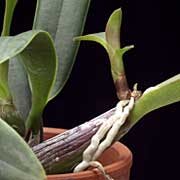
aberrant (ab-AIR-ant) Unusual or exceptional; a plant or structure that varies from the normal or typical.
abortion (a-BORE-shun) Premature bud or flower drop or poorly developed organ.
abortivus, -a, -um (ab-or-TYE-vus) Imperfectly formed or rudimentary; abortive.
abruptus, -a, -um (ab-RUP-tus) Broken off, or ending suddenly; abrupt.
Acacallis (a-ka-KALL-iss) Now considered synonymous with Aganisia, a genus of 3 species from northern South America related to Zygopetalum, described by Lindley in 1839.
Acampe (a-KAM-pee) A genus of about 7 tropical Asian and African orchids related to Vanda and described by Lindley in 1853, the name derived from the Greek in reference to the brittle rigidity of the small flowers.
Acanthophippium (a-canth-oh-FIP-ee-um) A terrestrial genus of about 15 species from tropical Asia. Blume first described the genus in 1825. He coined the generic name from two Greek words meaning "thorn" and "saddle," probably a reference to the unusual lip.
acaulescent: Dendrobium purpureum has acaulescent flowers.
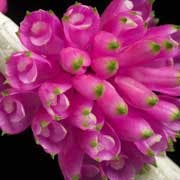
acaulescent (a-kawl-ESS-ent) Stemless, or apparently stemless.
acaulis, -e (a-KAW-lis) Having no stem, or only a very short stem.
accessory buds (AK-cess-ORE-ee buds) Buds in addition to those in axils.
accrescent (a-KREE-shent) Said of floral segments enlarging with age.
aceriform (uh-SEER-uh-form) Having leaves similar to those of maple trees.
acerose (as-uh-rohs) Shaped like a needle.
achlamydeous (ak-luh-MID-ee-uhs) Having no corolla or calyx.
Acianthus (A-SEE-an-thus) The 21 terrestrial species in this genus range from Australia north to the Solomon Islands. The genus was first described by R. Brown in 1810. The name comes from the Greek and means "needle flower," a reference to the slender, acuminate sepals and petals.
acicularis, -e (a-sik-yew-LAIR-is) Pointed; needlelike.
acinaciformis, -e (a-sin-a-si-FORM-is) Shaped like a curved sword or scimitar.
Acineta (a-sin-EE-ta) A pendent-flowered genus of about 18 species allied to Peristeria, founded by Lindley in 1843, the name referring to the immobility of the lip.
Aclandiae: Cattleya aclandiae, named after Lady Ackland.
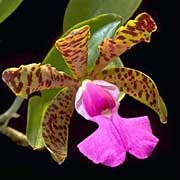
aclandiae (ak-KLAN-dee-eye) In compliment to the late Lady Ackland, wife of Sir Thomas D. Ackland, of Killeton, near Exeter, by whom the Cattleya so named was introduced from Brazil.
Acoridium (A-KOR-id-ee-um) There are approximately 60 epiphytic species of this genus native to the Philippines. Nees and Meyen founded the genus in 1843 and used the diminutive for acorum because the leaves resembled those of Acorus in the Araceae. The species in this genus are now considered to belong to Coelogyne.
acotyledonous (A-kot-el-EED-un-us) Having no cotyledons.
Acriopsis (AK-ree-op-sis) The seven epiphytic species of this genus are wide spread from Australia to Nepal and east to the Solomon Islands. Blume, in 1825, described the genus and coined the generic name from the Greek word for "locust" to describe the unique column.
acrotonic (ah-KROW-tawn-ik) Developing at the tip.
actinomorphic (AK-tin-O-more-fik) Said of a symmetrical flower capable of bisecting in two or more planes into like halves.
aculeatus, -a, -um (ak-yew-lee-AY-tus) Prickly; sharp-pointed; aculeate.
acuminatus, -a, -um (ak-yew-min-AY-tus) Tapering into a long narrow point; acuminate.
acutus, -a, -um (ak-YEW-tus) With a sharp but not tapering point; an angle of less than 90 degrees; acute.
Ada (AY-da) A genus of 16 species from Central and northern South America, allied to Brassia described by Lindley in 1853. The name refers to Ada, sister of Artimisia in Caria, a historical character.
AD/AOS An American Orchid Society award denoting an Award of Distinction, which is given once to a cross, exhibited individually or collectively, representing a worthy new direction in breeding.
adaxial (add-AXE-ee-al) Toward the axis.
adherent (ad-HEER-ent) Attached or joined, though normally separate.
adnatus, -a, -um (ad-NAY-tus) Having one organ attached wholly or in part to a dissimilar organ; joined together; adnate.
aduncus, -a, -um (a-DUN-kus) Curved inward; hooked; aduncous.
adventitious (ad-ven-TISH-us) Referring to roots not directly derived from the embryonic root or radicle. All orchid roots are adventitious.
adventive (ad-VEN-tive) Growing spontaneously, but not native; an imperfectly or partially naturalized exotic.
aemulus, -a, -um (EYE-mew-lus) Rivaling; hence superior, very handsome.
Aerangis: Aerangis modesta is found on the island of Madagascar.

Aerangis (ay-er-RANG-giss) An African genus of about 50 species related to Angraecum, established by Reichenbach in 1865, the name meaning "air vessel," probably in allusion to the long spur.
Aeranthes (ay-er-AN-theez) A genus of about 48 species of Sarcanthine orchids chiefly from Madagascar and adjacent islands, characterized by their complex flowers; the genus having been described by Lindley in 1824 and named in allusion to the epiphytic habit of the plants.
aerial roots (AIR-ee-al) Roots produced above or out of the growing medium.
Aerides (ay-air-EE-dees) A vandaceous genus of about 26 species from tropical Asia noted for their fragrant pendent racemes. The genus was first described by Juan Lourerio in 1790, who derived the generic name from Greek to describe these epiphytic plants.
Aeridovanda (ay-air-EE-doh-VAN-dah) A hybrid genus between Aerides and Vanda created in 1918.
aestival (eh-STEE-vuhl) Flowering or appearing in the summer.
aestivation (es-ti-VAY-shun) The arrangement of floral parts in the bud.
affinis, -e (af-FYE-nis) Related or similar to; often used in the sense of doubtful or ambiguous.
affinity (a-FINN-i-tee) A biological relationship among species or higher taxa dependent upon resemblance of general characters.
africanus, -a, -um (af-rik-KAY-nus) Native of Africa; African.
Aganisia (ag-an-IZ-ee-ah) A genus of three tropical South American orchid species related to Zygopetalum, some of which are blue-flowered; it was founded by Lindley in 1839. Acacallis is now considered to be synonymous.
agar (AH-ger) Agar-agar; a gelatinous substance derived from certain seaweeds and used as a solidifying agent in culture media; the culture medium made from agar and used for germinating orchid seed, meristem tissue and the like.
agglomerate (a-GLOM-er-ayt) To gather together in a cluster or mass; collected into a mass but not coherent.
agglutinate (a-GLOO-tin-ayt) To unite together with some sticky or viscous substance; united as with a glue.
aggregatus, -a, -um (ag-greg-GAY-tus) Clustered in a dense mass; aggregate.
ala (alae) A wing (wings).
Alamania (AL-ah-MAN-ee-ah) This monotypic (having only one species) epiphytic genus from Mexico was described by La Llave and Lexarza in 1825 and named in honor of their Mexican friend Don Lucus Alaman, a public official.
alatus, -a, -um (al-AY-tus) Winged; having wings or winglike parts; alate.
alba or album (AL-buh, AL-bum) White; often used to describe a white or pale phase of a species or hybrid whose flowers normally are colored.
albescens (al-BESS-senz) Whitish; becoming white.
albidofulvus, -a, -um (al-bid-oh-FULL-vus) Yellow and white.
albidus, -a, -um (AL-bid-us) Whitish.
albino (al-BYE-no) A plant with a marked deficiency in pigmentation.
albostriatus, -a, -um (al-bo-strye-AY-tus) Striped with white.
albus, -a, -um (AL-bus) White.
Alexander, H.G. (1875—1972) British orchid grower and hybridizer associated with the famous Westonbirt orchids, first as grower to Sir George Holford and, after Sir George's death in 1926, as head of firm of H.G. Alexander, Ltd.
alifolius, -a, -um (al-lee-FOH-lee-us) Winged-leaved.
allele (ah-LEEL) One of the alternate forms of a given gene, the alleles being dominant, recessive or incompletely dominant.
Allen, Paul (1911—1963) American orchidologist with extensive knowledge of Costa Rican and Panamanian orchids, coauthored with L.O. Williams the Orchidaceae of the Flora of Panama (1946—1949).
alliaceous (al-ee-AY-shus) Smelling or tasting like garlic.
allopatric (al-O-PAT-rick) Being present in different areas.
alloploid (AL-loh-ployd) Individuals that arise after crossing two species or genera and contain genetically different chromosome sets from each of the parents; the chromosome sets are homoeologous (completely homologous in an ancestry) to each other. Each set being present either once (diploid) or in greater numbers (allopolyploid).
aloifolius, -a, -um (al-oh-i-FOH-lee-us) With leaves like an aloe.
alpestris, -e (al-PEST-ris) Of the lower mountains.
alpinus, -a, -um (al-PYE-nus). From high mountains; alpine.
alternate (awl-ter-NATE) Any arrangement of leaves or other parts not opposite or whorled; placed singly at different heights on the axis or stem.
altissimus, -a, -um (al-TISS-eh-mus) Very tall, or tallest of its congeners.
altus, -a, -um (AL-tus) Tall.
alveolatus, -a, -um (al-vee-oh-LAY-tus) Honeycombed, or pitted with angular separated depressions; alveolate.
AM/AOS An American Orchid Society flower award denoting an Award of Merit; given to an orchid species or hybrid that scores between 80 and 89 points out of a possible 100 points. If given by another society, e.g., Royal Horticultural Society (London), it would read AM/RHS. This is the way it appears on plant labels.
amabilis: Phalaenopsis amabilis, the pretty Phalaenopsis.
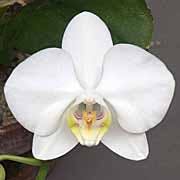
amabilis, -e (ah-MAH-bill-iss) Lovely.
ambiguus, -a, -um (am-BIG-yew-us) Doubtful, uncertain; ambiguous.
Amblostoma (am-BLOW-stow-ma) This South and Central American genus consists of nine species. Scheidweiler described this epiphytic genus in 1838 and coined the name from the Greek words for "blunt" and "mouth," a reference to the fact that the lip is attached to the column. This name is now considered to be synonymous with Epidendrum.
amboinensis, -e (am-boy-NEN-sis) Native to the island of Amboina in the Malayan archipelago.
Ames, Blanche (1878—1969) Wife of Oakes Ames, noted for her fine illustration talent, she designed the Society's logo, which is rendered on the AOS Gold Medal of Achievement, which she received in 1924.
Amesiella (Ames-EE-el-ah) Originally thought to be an Angraecum until Garay validated it as a genus in 1972 and named in honor of Oakes Ames, a Harvard botanist. This epiphytic genus comes from the Philippines and contains three species.
Ames, Oakes (1874—1950) Prominent American orchidologist, author of numerous taxonomic works and papers, and recipient of the AOS Gold Medal of Achievement in 1924, he established the Oakes Ames Orchid Herbarium and Library at Harvard University where he taught and worked for more than 50 years.
amesianus, -a, -um (aims-ee-AY-nus) Commemorating a member of the Ames family.
amethystinus, -a, -um (am-eh-this-TYE-nus) Pale violet in color.
amethystoglossus, -a, -um (am-e-this-toh-GLOSS-us) Having an amethyst-colored lip.
amoenus, -a, -um (am-EEN-us) Charming; delightful.
amorphous (a-MORE-fuss) Formless; of no definite or constant form.
amphigean (am-fi-JEE-an) Found in both hemispheres; of both Old World and New World; said of the distribution of plants.
amplexicaulis, -e (am-plex-i-KAW-lis) With leaves or bracts clasping the stem.
ampliatus, -a, -um (am-plee-AY-tus) Enlarged.
amplus, -a, -um (AM-plus) Large and thus fine, noble.
ampullaceus, -a, -um (am-pew-LAY-see-us) Flask- or bottle-shaped.
Anacamptis (AN-ah-CAMP-tis) There are twelve terrestrial species and numerous varietal forms and natural hybrids iin this genus from Europe, Asia Minor and North Africa. Richard described the genus in 1818 and derived the generic name from the Greek word anakamptoin (to bend back) to describe the reflexed pollinia.
analogous (an-AL-o-gus) Related in function or use but not in origin.
anastomosing (a-NASS-toh-moh-zing) Netted; interveined; said of leaves marked by a network of veins.
anceps (AN-seps) Two-edged, such as in a flattened stem.
ancipitous (an-SIP-i-tus) Compressed or flattened, two-edged.
ancipital (an-SIP-i-tahl) Having two edges.
Ancistrochilus: Ancistrochilus rothschildianus is one of two species in the genus.
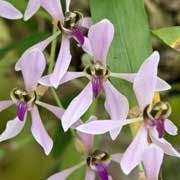
Ancistrochilus (an-siss-troe-KYE-luss) The 2 species in this genus are found in tropical Africa. The genus was first described in 1907 by Finet, who coined the generic name from two Greek words meaning "hook" and "beak," a reference to the hooklike rostellum found in these epiphytic species.
androgynous (an-DROJ-in-us) Having both male and female flowers on the same inflorescence; being both male and female; hermaphroditic.
androecium (an-DREE-see-um) The stamen-bearing or "male part" part of a flower; the stamens spoken of collectively.
aneuploid (an-EWE-ployd) A genetic aberration having a chromosome number that is not a multiple of the base number.
angiosperm (AN-jee-oh-spurm) Any plant of a class (Angiosperma) having the seeds in a closed ovary; a flowering plant.
angraecoid (an-GREE-koyd or an-GRYE-koyd) African orchids resembling Angraecum in habit.
Angraecopsis. A widespread tropical African and Madagascar genus of 16 epiphytic species first described by Kraenzlin in 1900. The generic name indicates that the plants look like Angraecum.
Angraecum (an-GREY-kum or an-GRYE-kum) A genus of over 200 species of African vandaceous orchids centered mainly in Africa and Madagascar, the name being Latinized from the Malay Angurek, which refers to all epiphytic orchids of similar habit. It was established by Bory in 1804.
Angranthes (an-GRAN-theez) A hybrid genus between Aeranthes and Angraceum created in 1975.
Anguloa (an-gyew-LOH-ah) A genus of nine species and numerous natural hybrids from the Andes, allied to Lycaste. It was named in 1794 by Ruiz and Pavon in honor of Don Francisco de Angulo, Director of Mines in Peru.
Angulocaste (an-gyew-low-CASS-tee) A hybrid genus between Anguloa and Lycaste created in 1903.
angustifolius, -a, -um (an-gus-ti-FOH-lee-us) Having narrow leaves.
Anneliesia (ann-eh-LEES-ee-ah) This Brazilian epiphytic genus was described by Brieger and Lueckel in 1903 and named in honor of Brieger's wife, Anneliese. It is now considered by many taxonomists to be synonymous with Miltonia.
annual (an-yew-ul) A plant that completes its life cycle from seed to death in one year.
annularis, -e (an-yew-LAIR-is) Ring-shaped.
annulatus, -a, -um (an-yew-LAY-tus) Furnished with rings.
Anoectochilus (ah-nek-toh-KYE-luss) A genus of about 51 species of "jewel orchids" found in Southeast Asia and Australia closely related to Macodes, described by Blume in 1825, the name referring to the open aspect of the lip.
anomalus, -a, -um (an-OM-al-us) Deviating from the normal or type; abnormal; anomalous.
anosmus, -a, -um (an-OZ-mus) Having no scent.
Ansellia (an-SELL-ee-a) A genus of one rather variable epiphytic or lithophytic orchid species from tropical Africa, named by Lindley in 1844 in honor of John Ansell, English botanist of the Royal Horticultural Society's Chiswick Gardens.
antenniferus, -a, -um (an-ten-IF-fer-us) Bearing antennae.
anterior (an-TEER-ee-or) On the front or forward end or side of an organ or flower.
anther (AN-ther) The part of a stamen containing the pollen; in orchids the top part of the column.
anthelate Having long branches bearing flowers.
anther cap (AN-ther kap) The covering of the pollen-masses on the flower's column; the operculum.
anthesis (an-THEE-siss) The period or state of expansion in a flower.
anthocyanin (an-THO-sigh-a-nin) A type of naturally occurring flavonoid pigment that is especially common within flowers and is responsible for red through blue colors; these pigments vary in color according to the pH of the cell sap, presence of metal ions and the concentration of co-pigments.
antipodal (an-TIP-oh-dal) On the opposite sides of the globe; diametrically opposite.
antrorse (an-TRORSS) Directed forward or upward (opposite of retrorse).
apertus, -a, -um (ap-ERT-us) Exposed; bare; open.
apetalous (a-PET-a-lus) Having no petals.
apex (AY-pex) The tip of an organ.
Aphids: cause damage to soft plant tissue.
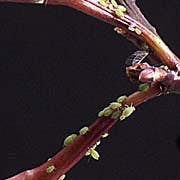
aphid (AY-fid) A plant-sucking insect that attacks soft tissue.
aphyllus, -a, -um (a-FILL-us) Without leaves, or nearly so; aphyllous.
apiatus, -a, -um (a-pee-AY-tus) Beelike.
apical (AY-pik-al) At or pertaining to the tip of any structure.
apiculatus, -a, -um (a-pik-yew-LAY-tus) Ending abruptly in a short sharp point; apiculate.
apicule (AY-pik-yewl) A short-pointed tip at the apex of a leaf or floral segment.
apiferus, -a, -um (a-PIFF-er-us) From apis, a bee, and fero, to bear; literally, bearing bees, alluding to the beelike shape of the flowers.
Aplectrum (ay-PLEK-trum) A monotypic genus from North America, related to Corallorhiza and Hexalectris. First described by Nuttall in 1818, the name is derived from the Greek meaning "without a spur," in allusion to the spurless lip of the flower.
apocarpous (ap-uh-KAR-puhs) Having separate carpels.
apogamous (ap-oh-GAM-us) Said of pods developing without fertilization.
apomixis (ap-oh-MIX-us) The production of seeds through asexual methods instead of the normal sexual means.
apomorphy (AP-oh-morf-ee) A cladistic term defining a derived character state.
appendage (uh-PEN-didge) An attached subsidiary or secondary part.
appendiculatus, -a, -um (a-pen-dik-yew-LAY-tus) Having appendages, such as a crest, hairs, etc.
appressus, -a, -um (ap-PRESS-us) Pressed close to, or lying flat against another organ.
approximate (uh-prox-eh-MATE) Situated near or close together.
apterus, -a, -um (ap-TER-us) Wingless.
AQ An American Orchid Society award denoting an Award of Quality, awarded once to a cross, exhibited by a single individual as a group of not less than 12 different clones or the inflorescences thereof, of a raised species or hybrid that may or may not have been made before, when the result is a sufficient improvement over the former type. At least one cultivar exhibited must receive, or have received, a flower quality award.
aquatic Growing or living in water.
Arachnis (a-RACK-niss) A genus of 11 tropical Asiatic orchid species related to Renanthera and Vanda, named by Blume in 1825 in reference to the spiderlike flowers.
arachnoid (a-RACK-noyd) Cobwebby, by way of soft and slender entangled hairs; also spider-like; similar to Arachnis.
arboreous (ahr-BORE-ee-us) Pertaining to trees.
arcuate (AR-kyew-ayt) Arched or curved like a bow.
aremiacus ( Being fragrant.
areole (AIR-ee-ole) A small area on a surface; an interstice, such as between veins of a leaf.
Arethusa (air-eh-THEW-za) A genus of one bog orchid species from North America known to Linnaeus in 1753 but named earlier by Gronovius in dedication to the wood nymph Arethusa, who fled from the river god Alpheus, and entered Sicily as a fountain. At one time, a second species was described as Arethusa japonica however that species is now considered to belong to Eleorchis.
argenteus, -a, -um (ar-JEN-tee-us) Silvery.
argus (AR-gus) A specific name in reference to Argus, the hundred-eyed monster of Greek mythology sent to watch Io.
arietinus, -a, -um (a-ri-eh-TYE-nus) Shaped like a ram's head.
aristatus, -a, -um (a-ris-TAY-tus) Bearded; furnished with a bristle-like appendage; aristate.
armed (are-md) Provided with any kind of strong and sharp defense, such as thorns, spines, prickles, barbs, etc.
armeniacus, -a, -um (ar-men-i-AY-kus) Apricot-colored.
Armodorum (are-mow-DOOR-um) South China, Southeast Asia and the Malay Peninsular are home to the four species of epiphytic or terrestrial orchids in this genus. The generic name was derived by Breda in 1827 from two Greek words meaning "crack in the wall" and "gift." The name indicates that these plants grow in cracks in rocks in their native habitat.
aromaticus, -a, -um (air-oh-MAT-ik-us) Fragrant; aromatic.
Arpophyllum (ar-poh-FILL-um) A genus of approximately four species of mostly Central American orchids often called "hyacinth orchids" because of the dense spike of rose-colored flowers, it is related to Ponera. It was described in 1825 by La Llave and Lexarza, the sickle-shaped leaves of the type species giving rise to the generic name.
articulatus, -a, -um (ar-tik-yew-LAY-tus) Jointed; articulate.
artificial hybrid (ar-ti-FISH-ul HYE-brid) The offspring of an artificial cross between two dissimilar parents, that is, parents not of the same species of hybrid grex; any plant progeny produced with man as the pollinating agent.
Arundina: Arundina gramnifolia is wide-spread in tropical Asia.
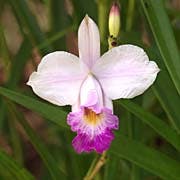
Arundina (air-un-DYE-na) A monotypic genus of orchids similar to Sobralia, described by Blume in 1825, the name referring to the reedlike stems. Native to Southeast Asia. Has become naturalized in many tropical countries.
ascendens (a-SEN-denz) Rising somewhat obliquely or curving upward; ascending.
Ascocenda (ass-koh-SEN-dah) A hybrid genus between Ascocentrum and Vanda created in 1949.
Ascocentrum (ass-koh-SEN-trum) A genus of about 13 compact-growing monopodial orchids from Southeast Asia and the Malayan Archipelago, allied to Vanda (the hybrid being Ascocenda), It was described by Schlechter in 1913, the name referring to the baglike spur at the base of the lip.
Ascoglossum (ass-koh-GLOSS-um) A monotypic genus from New Guinea and the Solomon Islands that was described by Schlechter in 1913. He derived the generic name from two Greek words meaning "bag" and "tongue" to describe the baglike lip with its pointed midlobe.
asepalous (ay-SEP-a-lus) Having no sepals.
asexual (ay-SEK-shu-al) Sexless; without involving sex, such as a vegetative propagation.
Aspasia (a-SPAY-zee-a) A genus of about nine species in the Oncidium Alliance, described by Lindley in 1832, the name in tribute to Aspasia, wife of Pericles.
asper, -a, -um (AS-per) Rough.
asperatus, -a, -um (as-per-AY-tus) Roughened; asperate.
assurgent (ass-UR-gent) Ascending.
asymbiotic (ay-sim-bi-AH-tik) Without symbiosis; referring to a method of germinating orchid seed without the presence of fungi.
asymmetrical (ay-sim-MET-ri-kal) Not symmetrical; having no regular shape.
atratus, -a, -um (a-TRAY-tus) Blackish; dark.
atropurpureus, -a, -um (a-troh-pur-PUR-ee-us) Dark purple.
atrorubens (at-roh-REW-benz) Deep reddish.
attenuatus, -a, -um (at-ten-yew-AY-tus) Narrowing to a point; attenuated.
augustifolius, -a, -um (aw-gus-ti-FO-lee-us) Having broad leaves.
augustus, -a, -um (aw-GUS-tus) Majestic; noble; august.
Aurantiaca: Gurianthe aurantiaca has orange flowers.
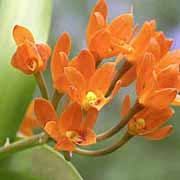
aurantiacus, -a, -um (aw-ran-tee-AY-kus) Orange-colored.
aureoflavus, -a, -um (aw-ree-o-FLAY-vus) Golden yellow.
aureus, -a, -um (AW-ree-us) Gold-colored; golden.
auricle (AW-rik-ul) A small earlike appendage or lobe.
auriculatus, -a, -um (aw-rik-yew-LAY-tus) Furnished with earlike appendages; auriculate.
australasia (aw-struh-LAY-shuh) A variably defined biogeographic area that includes Australia, New Guinea and associated biogeographic area, frequently identical to the area east of Wallace's line.
australis, -e (aw-STRAY-lis) Southern.
autotrophic (aw-TROW-fick) Having the ability to produce its own food.
autophyte (AW-toh-fite) A green plant capable of manufacturing its own food, neither saprophytic nor parasitic.
autoploid (AW-toh-ployd) Individuals with chromosome sets characteristic of the species in question; the chromosome sets are homologous to each other. Each set being present either once (diploid) or in greater numbers (autopolyploid).
autumnalis, -e (aw-tum-NAY-lis) Autumn-flowering; autumnal.
auxin (AWK-zin) A class of plant hormones responsible for regulating certain types of growth, e.g., apical dominance.
auxotroph (AWKS-oh-trohf) An organism that has nutritional requirements for specific substances, e.g. enzymes, proteins, carbohydrates.
awl-shaped (ahl-shaped) Narrow and sharp-pointed; gradually tapering from base to a slender or stiff point; subulate.
awn (awn) A bristlelike part or appendage; any small, pointed process.
axil (AK-sil) The angle between a branch or leaf and the stem or axis from which it arises.
axillaris, -e (ax-ill-AIR-is) Borne in the axil; axillary.
axis (AK-is) The main or central line of development of any plant or organ; the main stem.
azalea pot (uh-ZAYL-yuh pot) A proportionately broad, shallow pot, usually two thirds the height of a standard pot.









